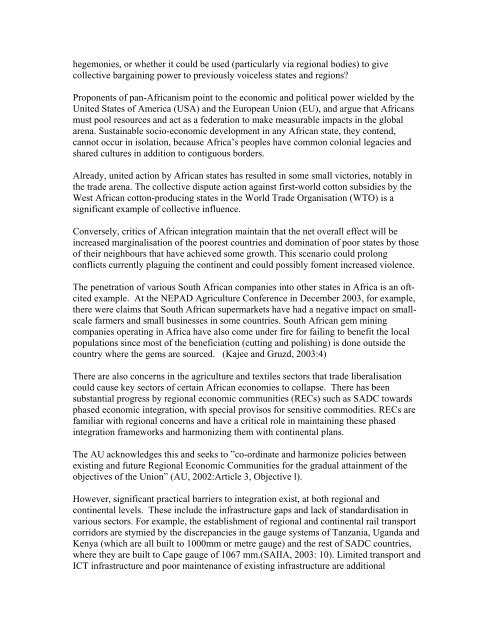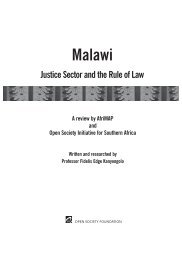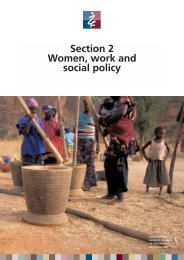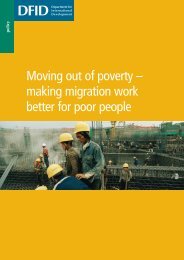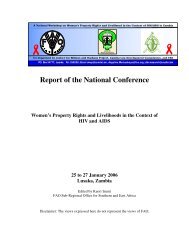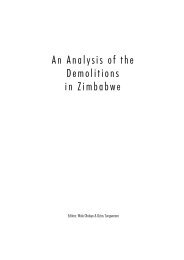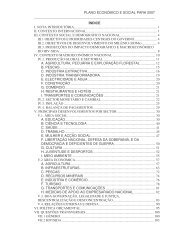The African Union Organs and the African Peer Review ... - SARPN
The African Union Organs and the African Peer Review ... - SARPN
The African Union Organs and the African Peer Review ... - SARPN
You also want an ePaper? Increase the reach of your titles
YUMPU automatically turns print PDFs into web optimized ePapers that Google loves.
hegemonies, or whe<strong>the</strong>r it could be used (particularly via regional bodies) to givecollective bargaining power to previously voiceless states <strong>and</strong> regions?Proponents of pan-<strong>African</strong>ism point to <strong>the</strong> economic <strong>and</strong> political power wielded by <strong>the</strong>United States of America (USA) <strong>and</strong> <strong>the</strong> European <strong>Union</strong> (EU), <strong>and</strong> argue that <strong>African</strong>smust pool resources <strong>and</strong> act as a federation to make measurable impacts in <strong>the</strong> globalarena. Sustainable socio-economic development in any <strong>African</strong> state, <strong>the</strong>y contend,cannot occur in isolation, because Africa’s peoples have common colonial legacies <strong>and</strong>shared cultures in addition to contiguous borders.Already, united action by <strong>African</strong> states has resulted in some small victories, notably in<strong>the</strong> trade arena. <strong>The</strong> collective dispute action against first-world cotton subsidies by <strong>the</strong>West <strong>African</strong> cotton-producing states in <strong>the</strong> World Trade Organisation (WTO) is asignificant example of collective influence.Conversely, critics of <strong>African</strong> integration maintain that <strong>the</strong> net overall effect will beincreased marginalisation of <strong>the</strong> poorest countries <strong>and</strong> domination of poor states by thoseof <strong>the</strong>ir neighbours that have achieved some growth. This scenario could prolongconflicts currently plaguing <strong>the</strong> continent <strong>and</strong> could possibly foment increased violence.<strong>The</strong> penetration of various South <strong>African</strong> companies into o<strong>the</strong>r states in Africa is an oftcitedexample. At <strong>the</strong> NEPAD Agriculture Conference in December 2003, for example,<strong>the</strong>re were claims that South <strong>African</strong> supermarkets have had a negative impact on smallscalefarmers <strong>and</strong> small businesses in some countries. South <strong>African</strong> gem miningcompanies operating in Africa have also come under fire for failing to benefit <strong>the</strong> localpopulations since most of <strong>the</strong> beneficiation (cutting <strong>and</strong> polishing) is done outside <strong>the</strong>country where <strong>the</strong> gems are sourced. (Kajee <strong>and</strong> Gruzd, 2003:4)<strong>The</strong>re are also concerns in <strong>the</strong> agriculture <strong>and</strong> textiles sectors that trade liberalisationcould cause key sectors of certain <strong>African</strong> economies to collapse. <strong>The</strong>re has beensubstantial progress by regional economic communities (RECs) such as SADC towardsphased economic integration, with special provisos for sensitive commodities. RECs arefamiliar with regional concerns <strong>and</strong> have a critical role in maintaining <strong>the</strong>se phasedintegration frameworks <strong>and</strong> harmonizing <strong>the</strong>m with continental plans.<strong>The</strong> AU acknowledges this <strong>and</strong> seeks to ”co-ordinate <strong>and</strong> harmonize policies betweenexisting <strong>and</strong> future Regional Economic Communities for <strong>the</strong> gradual attainment of <strong>the</strong>objectives of <strong>the</strong> <strong>Union</strong>” (AU, 2002:Article 3, Objective l).However, significant practical barriers to integration exist, at both regional <strong>and</strong>continental levels. <strong>The</strong>se include <strong>the</strong> infrastructure gaps <strong>and</strong> lack of st<strong>and</strong>ardisation invarious sectors. For example, <strong>the</strong> establishment of regional <strong>and</strong> continental rail transportcorridors are stymied by <strong>the</strong> discrepancies in <strong>the</strong> gauge systems of Tanzania, Ug<strong>and</strong>a <strong>and</strong>Kenya (which are all built to 1000mm or metre gauge) <strong>and</strong> <strong>the</strong> rest of SADC countries,where <strong>the</strong>y are built to Cape gauge of 1067 mm.(SAIIA, 2003: 10). Limited transport <strong>and</strong>ICT infrastructure <strong>and</strong> poor maintenance of existing infrastructure are additional


